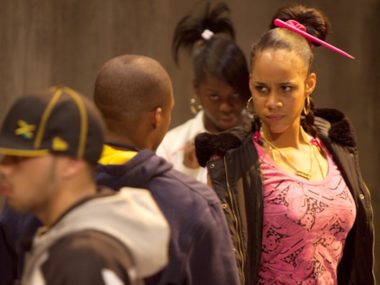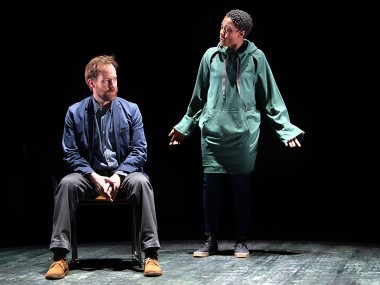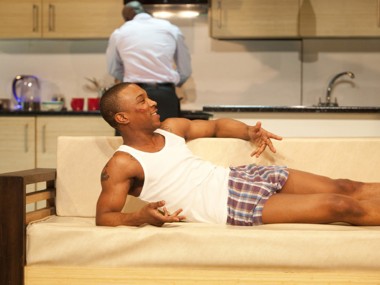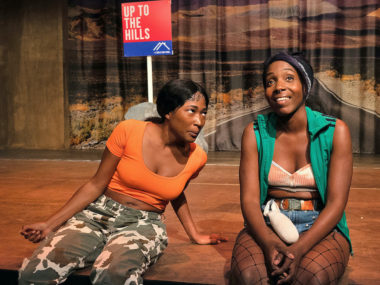G, Royal Court
Friday 30th August 2024
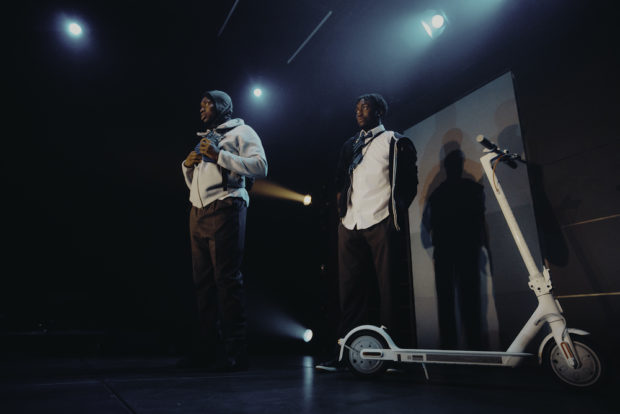
I live in Brixton, south London; in my street, for many years, a pair of trainers were up in the sky, hanging over the telephone wires. They were there for years, getting more and more soggy, more and more decayed. Urban myth called them a tribute to a dead gangster. There are similar urban legends aplenty in Tife Kusoro’s 75-minute new play, G, which won the George Devine Award last year, and now gets its premiere in the upstairs studio at the Royal Court. Its bare traverse staging features a pair of luminous white trainers hanging above the action. But, unlike the ones in my street, these never get dirty. They have remained pristine for 20 years. Magic.
So now we’re in the zone. Inspired by childhood fantasy and Afro-surrealism, this world is inhabited by three black schoolkids: 18-year-old Kaleem, still in Year 11 with his 16-year-old half-brother Kai, whose best friend is Joy, who identifies as a boy. As well as having the usual teenage preoccupations about school, parents and personal feelings, these three are also shown to inhabit a mythical universe, partly legendary, partly nightmarish. They share a belief, half credulously but with unabated teen enthusiasm, and especially when they are high, that the Gullyman Baitface steals the identities of black boys. All it takes is walking under a pair of trainers tossed over a telephone wire without covering your face. It must be a joke — or is it? When a local violent crime hits the headlines, it seems that Baitface has taken over the minds of Kaleem, Kai, and Joy. But how real is this apparition?
With enormous vigour and intelligence, Kusoro evokes not only the daily lives of the boys, their problems at school and Kaleem’s interest in a teen called Angel, but also the mythical galaxies swirling around their imaginations. It reminds me of John Keats’s idea of negative capability, “capable of being in uncertainties, mysteries, doubts without any irritable reaching after fact and reason”. At the same time, she offers a satirical picture of the surveillance state, the racism of the news media and a sympathetic account of black teen reality. Like many other kids, they don’t feel safe on the streets, and the threat of violence shadows their move across the urban territory. Kusoro deliberately and vividly creates an absorbing mix of dreams, images, metaphors — and leaves us constantly guessing about the truth of the experiences of her characters.
So while the plot is very slim, it does give a strong impression of a culture of black teen fears, and the play has a neat twist at the end which shows how an urban myth can sometimes be a piece of more down-to-earth cautionary advice, and the playwright’s characters are engagingly interesting. The oldest, Kaleem, is a mixture of street-smart know-how and emotional frustration, while his half-brother Kai is more unpredictable and excitable, and Joy is definitely more grounded (in a good way) than the other two. Each of them is vulnerable; each has a poetic way with words. Each is coming of age.
Kusoro acknowledges the influence of Antoinette Nwandu’s Pass Over, and the idea of Gullyman reminds me of the horribly sad story in Winsome Pinnock’s classic, Leave Taking, about a Caribbean migrant who aims high, but is destroyed by racism. In Kusoro’s free flow between the everyday, blasted memory and feverish night dreams, the play raps its ideas about youthful friendship with great sincerity, yet there are times when I think that the style of playwriting risks aestheticizing the real problems it alludes to, turning the ugly situations faced by many black youngsters into beautiful words and a strikingly entertaining show.
Ironically enough it is the sheer dazzle of Kusoro’s writing that often gets in the way of her storytelling. In G, the actual narrative of what happens to Kaleem, Kai and Joy is pretty slender, but has been dressed up not only with the imaginative evocation of urban myths, but also with flourishes of mysticism and mystery. For me, this is just a tad too richly literary, too obscure even, better suited to a book of poetry than the stage. That said, there are many excellent exchanges between the teens, who diss each other, chat shit about bum cracks and bad breath — and convey a thrilling sense of real life.
All this is accentuated by Monique Touko’s compellingly imaginative staging, which features designer Madeleine Boyd’s brain-sizzling images (including the balaclavas each character uses to hide their faces) and choreographer Kloé Dean’s sharp dance moves. Helped by Adam King (lighting) and Khalil Madovi (sound), projected words snake across the bare stage while the suspended trainers hang glowing in mid-air. Lances of light crisscross the stage, ultra white then blood red like a razor sunset, with Massive Attack’s pulses freezing your bloodstream. Tyler Forward’s flashes of video remind us of CCTV and the risks of mis-identification.
Touko’s young cast — Selorm Adonu (Kai), Kadiesha Belgrave (Joy) and Ebenezer Gyau (Khaleem) — have an amazing and thrilling energy, and they shine with conviction, while Dani Harris-Walters’s Baitface is both a great dancer and a beautifully menacing presence. He radiates unease. This is one of those shows where you just have to jump right in and go with the flow; the minute you start wondering too much about the coherence of the story, or looking for an explanation you will be lost. But the atmosphere and rich metaphors, the sense of ghosts and gothic chills, of ambiguity and uncertainty, have a real impact which announces the arrival of a fine new writer.
This review first appeared on The Arts Desk

